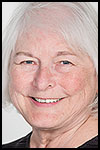Cassie Sollars: The echo of footsteps in a children's library
North Dakota pioneer Alfred M. Dickey, and his son Alfred E. Dickey, gave me a gift long ago that enriched my life immeasurably. They built a public library.
Naturally, it wasn’t just for me. And it didn’t begin as a library.
In 1901, the elder Mr. Dickey, only 55 at the time, organized a group of citizens in Jamestown, North Dakota, my hometown.
While his dream was to build and furnish a structure, he settled initially at providing a reading room in the Opera House Block downtown, along with furniture, books, periodicals and a custodian.
Use of the room was free to the public. And for $1 a year, people could borrow books.
Unfortunately, Mr. Dickey died shortly after the initial planning. But his son promised to carry out his father’s wishes.
Along with the original citizen group, Alfred E. Dickey formed a library board. Over the next few years, the board partnered with the city in creating a larger space at City Hall, allowing the library collection grow to more than 1,500 books and periodicals.
When the younger Dickey died in 1910, he bequeathed $20,000 to the library board for a structure, along with a $15,000 endowment for its upkeep, contingent on the city providing the land. His $35,000 gift would be worth just over $1 million today.
The city of Jamestown, with the help of donations from local businesses and private citizens, purchased land in 1917. The elegant library opened in 1919 and still operates today.
My first visit probably came sometime in 1956. I can still hear the echo of my steps on the marble stairway; sense the awe that only a 7-year-old can feel walking into such a grand, high-ceilinged structure; and remember the rich, textured scent of new books.
The children’s section, on the lower level, was a haven for kids. It was, however, a much quieter haven than those of modern children’s libraries.
I borrowed and read all kinds of books, but my favorites were biographies. Those of you from my era might remember the biography series with orange hardback covers in which dark silhouettes were used as illustrations.
The books were highly sanitized versions of all manner of male historical figures. But much to my delight, the selection included some notable female figures as well, including Harriet Beecher Stowe, Dolley Madison, Clara Barton, Amelia Earhart, Mary Todd Lincoln and Jessie Benton Fremont.
We could check out just four books a week, so you can imagine that magical place was a second home for me.
I have fewer memories of the adult section upstairs, as we moved away when I was 15. I do remember evenings of quiet study, researching term papers using the Dewey Decimal System, and joining giggling girlfriends trying to flirt with boys without experiencing the wrath of the librarian.
I used to the think Alfred E. Dickey and his father must have been much like Andrew Carnegie, the steel magnate who funded 1,700 libraries throughout the United States.
Of course, they were not. They were merely thoughtful, forward-thinking small town men with modest wealth in comparison to that of Mr. Carnegie.
The only library they founded was the one in Jamestown. But in doing so, they made a profound difference in my life — and those of thousands of other residents more than 112 years.
There are stories just like mine in towns and cities all over the country — hundreds of them through many generations right here in McMinnville.
Women and men who not only settled the area, but built businesses, donated land for public schools and a college. In so doing, they built a public infrastructure the envy of communities around the state.
This is what thriving communities do. They gather to honor the past, take care of the present and build for the future — a collective future. Together, individual members give the time and money they can afford to help make a difference.
Sadly, the problems of our world have grown so immense, so complex and critical, that the community road map for a successful world future is becoming woefully inadequate. To face world threats such as climate change, challenges in making low cost or free health care available for all of us, and a lack of trust in the scientific community to do the research we desperately require, we need more than the participation and dedication of a few steel barons.
Politics aside, if we are ever able to accomplish that Sisyphean feat, the personal characteristics we desperately require in today’s world are altruism, humanity, selflessness, philanthropy and self-sacrifice.
Yes, Elon Musk and Bill Gates and Jeff Bezos and Mark Zuckerberg and Michael Bloomberg and Warren Buffett — your immense fortunes are yours. You may spend them or not spend them as you wish.
Some of you have already given billions for our public good, but we need more.
We need you, and those like you, to serve as our models of altruism. Our teachers of selflessness. Our bastions of humanity. Our superheroes in the battle against greed.
If you need any help in learning these traits, there are billions of less affluent folks like us around the country — in places like McMinnville, Oregon, and Jamestown, North Dakota, who can help you practice these critical behaviors.
My richest memories and most powerful lessons aren’t from a Twitter feed or a Facebook page or my Amazon account. They begin with my family. That and the echo of footsteps on the marble staircase of my childhood library, leading to the treasures I found therein.
That reminds me. Let me tell you the story of Alfred M. Dickey and his son.









Comments